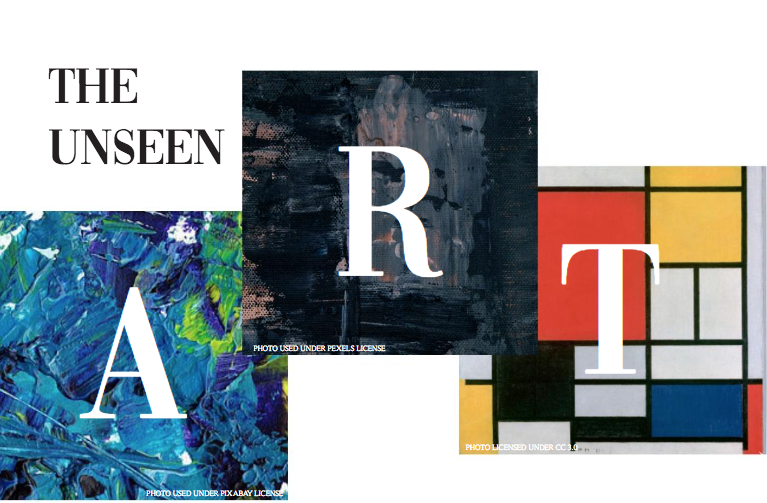The unseen art: misconceptions of modern art
March 13, 2019
blue canvas with a white stripe running down its middle sold for $48.3 million. A solid green portrait of an inverted trapezoid sold for $1.6 million. An empty frame for a “non-visible” piece of art sold for $10,000.
But is there any meaning behind this white stripe on a blue canvas? Is this inverted trapezoid coated in a fluorescent green really worth showcasing? Does the empty frame count as “art” if we can’t see it?
Framed ornately in museums and sold at auctions for millions, modern art has redefined and extended the public’s perception of art. Transcending traditional artwork, modern art denotes the abstractionism and free expression of an artist through minimalistic styles starting from the late 19th century.
Simplistic and abstract artwork pieced under the umbrella term of modern art may seem perplexing, which begs the question: what is the fine line between abstractionism and elementary scribbling? For many people, staring at works considered “art” — minimalistic and baffling canvases with seemingly little effort — is simply upsetting. A canvas littered with multicolored shapes: is that a work of art or a geometry project? If anyone can recreate art with their amateur artistic skills, then does modern art belong in a professional museum or on the walls of a 3rd grade classroom?
In the STEM-oriented overtone of MVHS, most people overlook the detailings of modern art, jumping to blunt conclusions that a solid-colored canvas is simply a color. Though we spend time analyzing literature or examining traditional works of art in school, we automatically follow our instincts upon seeing simplistic artwork and scoff at its apparent lack of effort. It’s easy to judge the quality of a work of art by its display of technical skill, regardless of the creative process required to create it.
At times, modern art draws close to the masterpiece of a 5 year old, favoring chaotic crayon scrawls and stick figures over traditional recognitions of art: realistic landscapes, portraits and scenes. However, most of modern art’s simplicity and lack of traditional aesthetics is intentional. According to The Art Story, modern artists stray towards minimalism, rejecting deep symbolism or emotional appeals and emphasizing the physical work itself instead.
Die, a sculpture created in 1962 by artist Tony Smith, was simply a six foot cube of steel. Weighing nearly 500 pounds, the metal cube’s lack of aesthetic appeal and “unreadable surface” was met with hostility, as the artwork countered traditional outlooks of art. However, Smith put more thought into creating the art than simply sculpting a basic geometric shape.
According to the National Gallery of Art, the title Die evokes multiple connotations of the word: “it alludes to die casting, to one of a pair of dice, and ultimately, to death.” Additionally, six feet wasn’t an arbitrary length for the cube either — Smith believed that a six foot cube was just large enough to represent human proportions without reaching a grandiose size. To Smith, the number six also carried additional meaning.
“Six feet has a suggestion of being cooked,” Smith said to The Art Story. “Six foot box. Six foot under.”
American artist Jackson Pollock’s artistic trademark, known as “poured paintings,” is the splattering of colored blots and dashes on the canvas. His piece called Blue Poles, created in 1952, has splatters of with reds, yellows and greys, coupled with blue streaks. According to The Art Story, the artwork is comprised of shoe footprints and shards of glass lodged in the canvas. A hypothesis of the artwork is that the “blue lines [were used] to unite disparate parts of the large picture,” evoking co-existence between color contrast and coherency.
“The poles are an unusually definite form in the ‘all-over’ configuration of Pollock’s poured paintings,” art curator Frank O’Hara said. “Various figurative connotations have been attributed to them — from totems to the swaying masts of tall ships.”
Modern art is often left open to interpretation, carrying numerous meanings, as opposed to traditional art, which tends to be less ambiguous. Modern art doesn’t play by the standards of conventional art, and artists are well aware of that. Works of art that seem overly minimalistic often compromise aesthetic glamour to convey an idea.
A modern artist’s ideas are often far more valuable than the physical construction of their art, which is why deceptively simple art pieces are valued highly and sold for millions. Whether an artwork’s themes are conveyed through its title, surroundings, composition or even dimensions, there is often a great deal of thought and planning to distinguish between art in modern art museums and paint splatters by kindergarteners.
Modern art is unique and noteworthy, transcending artistic conventions. Taking abstract notions and making a concrete piece out of it requires an ingenious thought process. The controversy amidst modern art’s ambiguity is what makes this art form so eye catching and original.
While it’s easy to ridicule modern art due to its inherent simplicity, it isn’t so different from other forms of art. In order to appreciate modern art, we must first understand it beyond our instinctual reasoning. Rather than taking one glance at a piece of art and making a judgement, we should learn to study the finer details. Modern art is thought out and intentional; the average person wouldn’t be able to simply replicate any art piece because it requires basic technical skills. Modern art has underlying meanings behind its minimalism that is more than what meets the eye; the inner workings are what make modern art pieces costly and valuable. Though it’s easy to imagine, most works of modern art could not, in actuality, be created by a 5 year old.



















